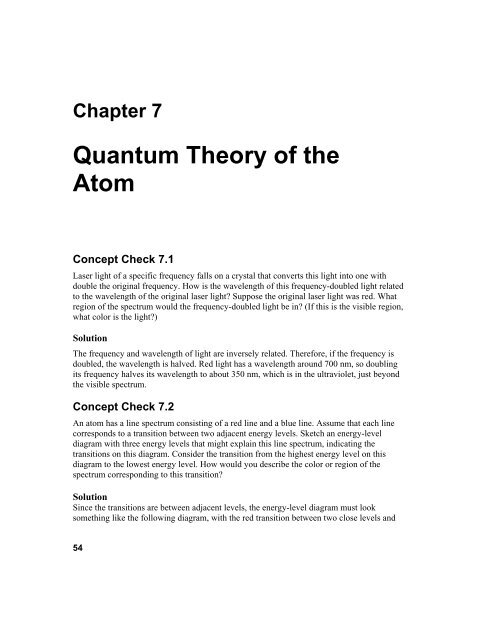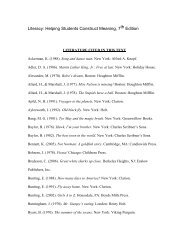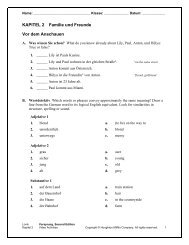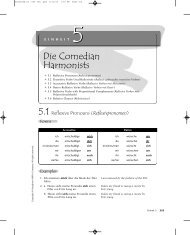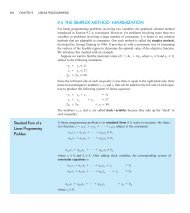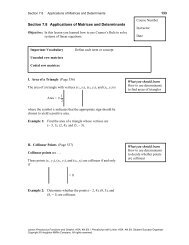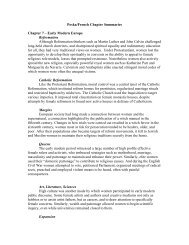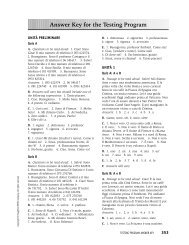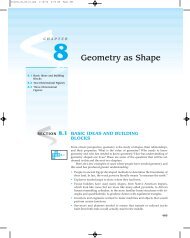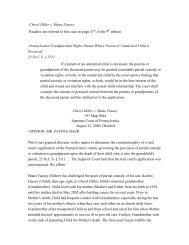Chapter 7: Quantum Theory of the Atom
Chapter 7: Quantum Theory of the Atom
Chapter 7: Quantum Theory of the Atom
Create successful ePaper yourself
Turn your PDF publications into a flip-book with our unique Google optimized e-Paper software.
<strong>Chapter</strong> 7<br />
<strong>Quantum</strong> <strong>Theory</strong> <strong>of</strong> <strong>the</strong><br />
<strong>Atom</strong><br />
Concept Check 7.1<br />
Laser light <strong>of</strong> a specific frequency falls on a crystal that converts this light into one with<br />
double <strong>the</strong> original frequency. How is <strong>the</strong> wavelength <strong>of</strong> this frequency-doubled light related<br />
to <strong>the</strong> wavelength <strong>of</strong> <strong>the</strong> original laser light? Suppose <strong>the</strong> original laser light was red. What<br />
region <strong>of</strong> <strong>the</strong> spectrum would <strong>the</strong> frequency-doubled light be in? (If this is <strong>the</strong> visible region,<br />
what color is <strong>the</strong> light?)<br />
Solution<br />
The frequency and wavelength <strong>of</strong> light are inversely related. Therefore, if <strong>the</strong> frequency is<br />
doubled, <strong>the</strong> wavelength is halved. Red light has a wavelength around 700 nm, so doubling<br />
its frequency halves its wavelength to about 350 nm, which is in <strong>the</strong> ultraviolet, just beyond<br />
<strong>the</strong> visible spectrum.<br />
Concept Check 7.2<br />
An atom has a line spectrum consisting <strong>of</strong> a red line and a blue line. Assume that each line<br />
corresponds to a transition between two adjacent energy levels. Sketch an energy-level<br />
diagram with three energy levels that might explain this line spectrum, indicating <strong>the</strong><br />
transitions on this diagram. Consider <strong>the</strong> transition from <strong>the</strong> highest energy level on this<br />
diagram to <strong>the</strong> lowest energy level. How would you describe <strong>the</strong> color or region <strong>of</strong> <strong>the</strong><br />
spectrum corresponding to this transition?<br />
Solution<br />
Since <strong>the</strong> transitions are between adjacent levels, <strong>the</strong> energy-level diagram must look<br />
something like <strong>the</strong> following diagram, with <strong>the</strong> red transition between two close levels and<br />
54
<strong>Quantum</strong> <strong>Theory</strong> <strong>of</strong> <strong>the</strong> <strong>Atom</strong> 55<br />
<strong>the</strong> blue transition between two levels more widely spaced. (The three levels could be spaced<br />
so that <strong>the</strong> red and blue transitions are interchanged, with <strong>the</strong> blue transition above <strong>the</strong> red<br />
one.)<br />
Level 3<br />
750 nm (red line)<br />
Level 2<br />
400 nm (blue line)<br />
Level 1<br />
The transition from <strong>the</strong> top level to <strong>the</strong> lowest level would correspond to a transition that is<br />
greater in energy change than ei<strong>the</strong>r <strong>of</strong> <strong>the</strong> o<strong>the</strong>r two transitions. Thus, <strong>the</strong> three transitions,<br />
from lowest to highest energy change, are in <strong>the</strong> order: red, blue, and <strong>the</strong> transition from <strong>the</strong><br />
highest to lowest level. This last transition would have <strong>the</strong> highest frequency and <strong>the</strong>refore<br />
<strong>the</strong> shortest wavelength. It would lie just beyond <strong>the</strong> blue portion <strong>of</strong> <strong>the</strong> visible spectrum, in<br />
<strong>the</strong> ultraviolet region.<br />
Concept Check 7.3<br />
A proton is approximately 2000 times heavier than an electron. How would <strong>the</strong> speeds <strong>of</strong><br />
<strong>the</strong>se particles compare if <strong>the</strong>ir corresponding wavelengths were to be about equal?<br />
Solution<br />
The de Broglie relation says that <strong>the</strong> wavelength <strong>of</strong> a particle is inversely proportional to both<br />
mass and speed. So, to maintain <strong>the</strong> wavelength constant while <strong>the</strong> mass increases would<br />
mean that <strong>the</strong> speed would have to decrease. In going from a particle with <strong>the</strong> mass <strong>of</strong> an<br />
electron to that <strong>of</strong> a proton, <strong>the</strong> speed would have to decrease by a factor <strong>of</strong> about 2000 in<br />
order to maintain <strong>the</strong> same wavelength. The proton would have to have a speed<br />
approximately 2000 times slower than an electron <strong>of</strong> <strong>the</strong> same wavelength.<br />
Conceptual Problem 7.19<br />
Consider two beams <strong>of</strong> <strong>the</strong> same yellow light. Imagine that one beam has its wavelength<br />
doubled; <strong>the</strong> o<strong>the</strong>r has its frequency doubled. Which <strong>of</strong> <strong>the</strong>se two beams is <strong>the</strong>n in <strong>the</strong><br />
ultraviolet region?
56 <strong>Chapter</strong> 7<br />
Solution<br />
Wavelength and frequency are inversely related. Moreover, ultraviolet light is at higher<br />
frequency than yellow light. Doubling <strong>the</strong> frequency <strong>of</strong> a beam <strong>of</strong> light would give that beam<br />
a higher frequency than yellow light, whereas doubling <strong>the</strong> wavelength would give that beam<br />
a lower frequency than yellow light. Consequently, <strong>the</strong> beam with frequency doubled must be<br />
<strong>the</strong> one in <strong>the</strong> ultraviolet region.<br />
Here is ano<strong>the</strong>r way to look at <strong>the</strong> problem. Energy is directly related to <strong>the</strong> frequency<br />
and inversely related to <strong>the</strong> wavelength. Thus, <strong>the</strong> beam whose frequency is doubled will<br />
increase in energy, whereas <strong>the</strong> beam whose wavelength is doubled will decrease in energy.<br />
Since yellow light is in <strong>the</strong> visible region <strong>of</strong> <strong>the</strong> spectrum, which is lower in energy than <strong>the</strong><br />
ultraviolet region (Figure 7.5), <strong>the</strong> beam whose frequency is doubled will be higher in energy<br />
and thus in <strong>the</strong> UV region <strong>of</strong> <strong>the</strong> spectrum.<br />
Conceptual Problem 7.20<br />
Some infrared radiation has a wavelength that is 1000 times larger than that <strong>of</strong> a certain<br />
visible light. This visible light has a frequency that is 1000 times smaller than that <strong>of</strong> some X<br />
radiation. How many times more energy is <strong>the</strong>re in a photon <strong>of</strong> this X radiation than <strong>the</strong>re is<br />
in a photon <strong>of</strong> <strong>the</strong> infrared radiation?<br />
Solution<br />
Frequency is inversely related to <strong>the</strong> wavelength. Thus, <strong>the</strong> infrared radiation with a<br />
wavelength that is one thousand times larger than <strong>the</strong> visible light would have a frequency<br />
one thousand times smaller than <strong>the</strong> visible light. But, <strong>the</strong> visible light has a frequency one<br />
thousand times smaller than that <strong>of</strong> <strong>the</strong> X radiation. This makes <strong>the</strong> frequency <strong>of</strong> <strong>the</strong> X<br />
radiation one million times larger than <strong>the</strong> frequency <strong>of</strong> <strong>the</strong> infrared radiation. Therefore,<br />
since energy is directly related to <strong>the</strong> frequency, <strong>the</strong> energy <strong>of</strong> <strong>the</strong> X radiation would be one<br />
million times as large as <strong>the</strong> energy <strong>of</strong> <strong>the</strong> infrared radiation.<br />
Conceptual Problem 7.21<br />
One photon <strong>of</strong> green light has less than twice <strong>the</strong> energy <strong>of</strong> two photons <strong>of</strong> red light. Consider<br />
two hypo<strong>the</strong>tical experiments. In one experiment, potassium metal is exposed to one photon<br />
<strong>of</strong> green light; in ano<strong>the</strong>r experiment, potassium metal is exposed to two photons <strong>of</strong> red light.<br />
In one <strong>of</strong> <strong>the</strong>se experiments, no electrons are ejected by <strong>the</strong> photoelectric effect (no matter<br />
how many times this experiment is repeated), whereas in <strong>the</strong> o<strong>the</strong>r experiment at least one<br />
electron is ejected. What is <strong>the</strong> maximum number <strong>of</strong> electrons that could be ejected during<br />
this experiment, one or two?
<strong>Quantum</strong> <strong>Theory</strong> <strong>of</strong> <strong>the</strong> <strong>Atom</strong> 57<br />
Solution<br />
That one color <strong>of</strong> light does not result in an ejection <strong>of</strong> electrons implies that that color has<br />
too little energy per photon. Of <strong>the</strong> two colors, red and green, red light has less energy per<br />
photon. So you expect that <strong>the</strong> experiment with red light results in no ejection <strong>of</strong> photons,<br />
whereas <strong>the</strong> experiment with green light must be <strong>the</strong> one that ejects electrons. (Two red<br />
photons have more than enough energy to eject an electron, but this energy needs to be<br />
concentrated in only one photon to be effective.) In <strong>the</strong> photoelectric effect, one photon <strong>of</strong><br />
light ejects at most one electron. Therefore, in <strong>the</strong> experiment with green light, one electron is<br />
ejected.<br />
Conceptual Problem 7.22<br />
An atom in its ground state absorbs a photon (photon 1), <strong>the</strong>n quickly emits ano<strong>the</strong>r photon<br />
(photon 2). One <strong>of</strong> <strong>the</strong>se photons corresponds to ultraviolet radiation, whereas <strong>the</strong> o<strong>the</strong>r one<br />
corresponds to red light. Explain what is happening. Which electromagnetic radiation,<br />
ultraviolet or red light, is associated with <strong>the</strong> emitted photon (photon 2)?<br />
Solution<br />
Ultraviolet radiation is higher in energy than red light (Figure 7.5). Since an atom that started<br />
in <strong>the</strong> ground state cannot emit more energy than it absorbed, <strong>the</strong> absorbed photon must be<br />
higher in energy than <strong>the</strong> emitted photon. This makes <strong>the</strong> emitted photon (photon 2) <strong>the</strong> red<br />
light.<br />
Conceptual Problem 7.23<br />
Three emission lines involving three energy levels in <strong>the</strong> magnesium atom occur at<br />
wavelengths x, 1.5x, and 3.0x nm. Which wavelength corresponds to <strong>the</strong> transition from <strong>the</strong><br />
highest to <strong>the</strong> lowest <strong>of</strong> <strong>the</strong>se three energy levels?<br />
Solution<br />
Energy is inversely proportional to <strong>the</strong> wavelength <strong>of</strong> <strong>the</strong> radiation. The transition from <strong>the</strong><br />
highest to <strong>the</strong> lowest energy levels would involve <strong>the</strong> greatest energy change and thus <strong>the</strong><br />
shortest wavelength, x nm.<br />
Conceptual Problem 7.24
58 <strong>Chapter</strong> 7<br />
An atom emits yellow light when an electron makes <strong>the</strong> transition from <strong>the</strong> n = 5 to <strong>the</strong> n = 1<br />
level. In separate experiments, suppose you bombarded <strong>the</strong> n = 1 level <strong>of</strong> this atom with red<br />
light, yellow light (obtained from <strong>the</strong> previous emission), and blue light. In which<br />
experiment or experiments would <strong>the</strong> electron be promoted to <strong>the</strong> n = 5 level?<br />
Solution<br />
In a transition from <strong>the</strong> n = 1 to <strong>the</strong> n = 5 energy level, an atom will absorb a photon with <strong>the</strong><br />
same energy as <strong>the</strong> photon that was emitted in <strong>the</strong> transition from <strong>the</strong> n = 5 to <strong>the</strong> n = 1<br />
energy level. Since yellow light was emitted, <strong>the</strong> experiment using yellow light will promote<br />
<strong>the</strong> electron to <strong>the</strong> n = 5 level.<br />
Conceptual Problem 7.25<br />
Which <strong>of</strong> <strong>the</strong> following particles has <strong>the</strong> longest wavelength?<br />
a. an electron traveling at x m/s<br />
b. a proton traveling at x m/s<br />
c. a proton traveling at 2x m/s<br />
Solution<br />
A proton is approximately 2000 times <strong>the</strong> weight <strong>of</strong> an electron. Also, from <strong>the</strong> de Broglie<br />
relation, l = h/mv, you see that <strong>the</strong> wavelength is inversely proportional to both <strong>the</strong> mass and<br />
<strong>the</strong> speed <strong>of</strong> <strong>the</strong> particle. Considering <strong>the</strong> protons in parts b. and c., since <strong>the</strong> mass is <strong>the</strong> same<br />
in both parts, <strong>the</strong> proton with <strong>the</strong> smaller speed, part b., will have a longer wavelength. Now,<br />
comparing <strong>the</strong> electron in part a. with <strong>the</strong> proton in part b., since both have <strong>the</strong> same speed,<br />
<strong>the</strong> electron in part a. with <strong>the</strong> smaller mass will have <strong>the</strong> longer wavelength. Therefore, <strong>the</strong><br />
electron in part a. will have <strong>the</strong> longest wavelength.<br />
Conceptual Problem 7.26<br />
Imagine a world in which <strong>the</strong> rule for <strong>the</strong> l quantum number is that values start with 1 and go<br />
up to n. The rules for <strong>the</strong> n and ml quantum numbers are unchanged from those <strong>of</strong> our world.<br />
Write <strong>the</strong> quantum numbers for <strong>the</strong> first two shells (i.e., n = 1 and n = 2).<br />
Solution<br />
For <strong>the</strong> first shell, <strong>the</strong> quantum numbers would have <strong>the</strong> following allowable values:<br />
n = 1; l = 1; ml = 0, +1, -1.<br />
For <strong>the</strong> second shell, <strong>the</strong> quantum numbers would have <strong>the</strong> following allowable values:<br />
n = 2; l = 1; ml = 0, +1, -1<br />
l = 2; ml = 0, +1, -1, +2, -2
<strong>Quantum</strong> <strong>Theory</strong> <strong>of</strong> <strong>the</strong> <strong>Atom</strong> 59


